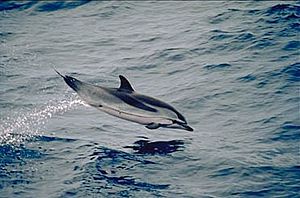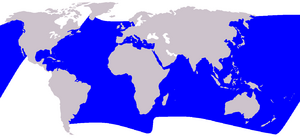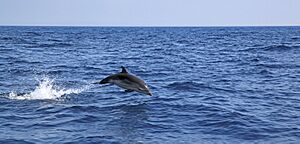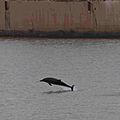Striped dolphin facts for kids
Quick facts for kids Striped dolphin |
|
|---|---|
 |
|
| A striped dolphin in full flight | |
 |
|
| Size compared to an average human | |
| Conservation status | |
| Scientific classification | |
| Genus: |
Stenella
|
| Species: |
coeruleoalba
|
 |
|
| Striped dolphin range | |
The striped dolphin (Stenella coeruleoalba) is a type of dolphin. It lives in both cool and warm waters all over the world. You can find it in every ocean! This dolphin is part of the oceanic dolphin family, called Delphinidae.
Contents
What Does a Striped Dolphin Look Like?
The striped dolphin looks similar to other dolphins in its habitat. But its colors make it easy to spot! Its belly can be blue, white, or even pink. Black stripes go around its eyes and run across its back to its flippers. These stripes get wider near the flippers.
Two more black stripes start behind its ear. One is short and stops above the flipper. The other is longer and thicker. It curves down under the belly before the tail. Above these stripes, the dolphin's sides are light blue or gray. All its fins and tail are black.
How Big Do Striped Dolphins Get?
When they are born, baby striped dolphins weigh about 10 kilograms (22 pounds). They are about 1 meter (3 feet) long. As adults, females grow to about 2.4 meters (8 feet) and males to 2.6 meters (8.5 feet). Females weigh around 150 kg (330 lb), and males weigh about 160 kg (352 lb).
Striped Dolphin Life Cycle and Reproduction
Female striped dolphins in the Mediterranean Sea become adults around 12 years old. In the Pacific Ocean, they mature between 7 and 9 years. These dolphins can live for about 55 to 60 years. A mother dolphin carries her baby for about 12 months. She usually has a new baby every three or four years.
How Do Striped Dolphins Behave?
Striped dolphins often travel in very large groups. These groups can have thousands of dolphins! In the Mediterranean and Atlantic, groups might be smaller. They sometimes swim with common dolphins too.
Striped dolphins are amazing acrobats. They often jump high out of the water. Sometimes, they come close to boats in the Atlantic and Mediterranean. But they are much shyer in the Pacific Ocean. In the eastern tropical Pacific, they are called "streakers." This is because they swim away very fast from boats to avoid them.
Where Do Striped Dolphins Live?
Striped dolphins live in warm and cool waters far from shore. You can find them in the North and South Atlantic Oceans. This includes the Mediterranean Sea and the Gulf of Mexico. They also live in the Indian Ocean and the Pacific Ocean.
They are usually found between 40 degrees North and 30 degrees South latitude. They like water temperatures from 10 to 26 degrees Celsius (50 to 79 degrees Fahrenheit). But they prefer water that is 18-22 degrees Celsius (64-72 degrees Fahrenheit).
In the western Pacific, scientists have seen them move in a special way. This is like a migration. But this pattern has not been seen in other areas. Striped dolphins seem to be common in most places they live. The total number of striped dolphins is more than two million! The farthest south a striped dolphin was found was near Dunedin, New Zealand, in 2017.
What Do Striped Dolphins Eat?
Adult striped dolphins eat small fish that live in open water. They also eat squid, octopus, krill, and other small sea creatures. In the Mediterranean Sea, they mostly eat squid. But in the northeastern Atlantic, they often eat fish, like cod. They can dive very deep, up to 700 meters (2,300 feet), to find food. They eat anywhere in the water where their prey is found.
How Do Humans Interact with Striped Dolphins?
People in Japan have hunted striped dolphins in the western Pacific for a long time. Today, some threats to these dolphins include noise from ships and pollution from nearby harbors.
It has been hard to keep striped dolphins in zoos or aquariums. Most attempts have not worked. Only a few caught in Japan for the Taiji Whale Museum have survived. Striped dolphins are one of the species hunted in the Taiji dolphin drive hunt.
Images for kids
See also
 In Spanish: Delfín listado para niños
In Spanish: Delfín listado para niños






